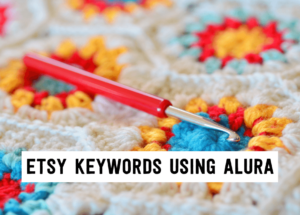
How to find the best Etsy keywords in 3 simple steps using Alura
If you want to be found in search results on Etsy, you need to optimize your product listing for SEO. And if you want to
join
join
If you have just started an Etsy shop, or if you are thinking about starting an Etsy shop and are learning more about it, it can be extremely confusing to understand all the fees that you are charged on your Etsy invoices. . .
At this point you might even have already taken a quick glance at the fee descriptions in the Etsy help docs but might still find it hard to wrap your brain around what is what . . . and you’re left wondering which fees you need to pay and which ones you don’t – some sound like they’re the same but apparently they’re not – and your brain starts to feel like it might just explode!
So my goal with this article is to make the Etsy fees clear and easy to understand – once and for all.
To do that I’ve made a super-helpful FREE worksheet that you will be able to fill out as we work through each fee in this article – you can print it out and fill it in as we go through each fee.

e-com sales on tap training
simple step-by-step plan to grow your online store sales into a consistent and predictable income with the Reliable eCom Sales System
So here is a picture of your free worksheet, and these are the different fees that you might end up paying. Some of these fees everyone pays, some of them only apply to you if you’re in a certain country or have a certain amount of sales each year, and some of them are services or features you can choose to use and it’s totally up to you.
What I’m going to do today is go through each of these: we will talk about the fees that everyone must pay and how to calculate them, I’ll explain the ones that you might have to pay and help you understand if they apply to your business or not, and then I’ll explain the fees for things that you can choose to do if you want that extra service for your business.
And as we go you can fill in this worksheet because you will understand if each one is applicable to you, and how much it will cost.
Once we’ve gone over all the different fees, I’ll sum up with some examples that show you some different scenarios and how the fees work out for each one, just to give you practical examples you can refer to.
So, ready? Let’s dive in.
So what I’m going to do to make this easier to understand is divide the fees into three categories:
For simplicity, for each fee I talk about today I will use US dollars in my examples.
Let’s start with the fees that everyone has to pay.
The first fee we will talk about is listing fees. Listing fees are the fees that you pay whether your products sell or not – they are a fee that Etsy charges to have your items displayed on the platform. It’s a bit like paying rent, something you pay for a little corner of Etsy.
For each product you list, you will pay a listing fee of $0.20 USD per listing. This fee covers 4 months of listing a single product on Etsy, which means that:
Now there are a few extra options based on the quantity you are selling or the inventory you have available, so let’s go through some examples to see what it looks like.
So let’s say the products you sell are one-of-a-kind items. Every item you sell is very, very specific and unique – you can’t recreate the same item, every item has an inventory of one and once you sell it, it’s gone forever.
So it’s truly one of a kind.
In this case, you would set the inventory to one, you would not set the listing to auto-renew because you don’t have more of that specific item to sell – it’s unique.
It will cost you 20 cents every 4 months until you sell it.
Let’s say you sell small silver sculptures, each one very unique. When one of your sculptures sells, that listing will disappear from Etsy and not be there anymore.
If one of your sculptures doesn’t sell for 4 months, the listing will remain on Etsy, but you will be charged a new 20-cent listing fee for the next 4 months.
If you don’t sell one-of-a-kind and can sell more than one quantity of the item you’re listing, you’ll likely turn on auto-renew so your listing doesn’t go off Etsy when it sells.
So in our candle example, let’s say you made a batch of 20 lavender-scented candles. When you create the listing you will enter the quantity of 20 that you have available and turn on auto-renew for your listing.
Then, each time a candle sells, instead of saying “sold out,” your listing will auto-renew, you will be charged a new $0.20 listing fee, and the listing will stay active on Etsy until the 20th candle is sold.
Etsy also has a fee they call the “multi-item listing fee,” which applies to situations where someone purchases a multiple quantity of the same item.
Let’s say you list your candles with the option for shoppers to purchase multiple candles at the same time. If you choose that option, each time you sell multiple candles you will be charged an additional $0.20 for each additional candle sold.
So if you have 10 lavender-scented candles ready to sell, you will create a listing and set the quantity available to 10 and enable multi-item purchases. When you publish that listing you will be charged a $0.20 listing fee.
If someone places an order for three candles, you have already paid the initial $0.20 listing fee, so Etsy will charge you two additional listing fees of $0.20 for the second and third candles that you sold in that order, so $0.40.
You can also create what is called a “private listing,” not to be confused with customizable or personalizable items where someone adds personalization on top of a listing (for example: text on a pillow, or a name on print, etc.).
This is truly for someone contacting you directly and asking you to work on a specific custom project with them, so you then create a listing just for them.
So let’s say one of your customers asked you if you could make a candle with lavender and orange scents mixed together – something you don’t currently offer. You will make a private listing and send it to that specific customer.
You won’t be charged the $0.20 fee until that specific buyer purchases the candle from your private listing.
If you still feel a little confused, what I want you to remember is that for every single item that you sell on Etsy, it is going to end up costing you 20 cents. Pretty much whatever happens, once you’ve sold an item it’s going to cost you 20 cents, and if you list an item it’s going to cost you 20 cents every 4 months (if it hasn’t sold in those 4 months).
Next let’s talk about transaction fees.
These fees are something that you must pay every time you make a sale: it’s basically a bill from Etsy that says “hey, you’ve made a sale, thanks to us! This is how much it’s gonna cost you” – and that fee (at the time I am writing this article) is 6.5%.
Now here’s where I see people getting confused: your transaction fee is going to be calculated from the total sale amount – including shipping and gift wrap charges.
Let’s look at an example to understand what it looks like:
Let’s say you sold one of your candles for $23, and the person who bought it wants it gift wrapped. Their bill will look like this:
Candle $23
Gift wrap $5
Shipping $5
Total $33
So for this order your transaction fee will be 6.5% x $33, or $2.15.
So in your worksheet you can go ahead and write in 6.5% under the HOW MUCH column for transaction fees – as this fee is the same for every seller, no matter where in the world you’re located.
The last fee you HAVE to pay for your Etsy shop is called a processing fee.
Processing fees sometimes get confused with transaction fees but they’re different and are ON TOP of the 6.5% transaction fees we just talked about.
They are another fee you pay each time you make a sale, and they are essentially a fee for the payment to be processed by whatever payment processor was used.
Before we discuss processing fees, I want to answer a question you may have, which is “Can I use Paypal for my Etsy shop?”
In a nutshell, the answer is “no not really, not anymore anyway”.
I know some of you may have seen or heard of shops on Etsy that use Paypal. This is because for a long time, Paypal was offered as a way to get paid on Etsy, but this has changed. Those shops very likely opened before April of 2021, when Etsy Payments (which is Etsy’s in-house payment processing system) basically became the only payment processor you can use (unless you’re in India, I’ll explain that in a minute) – but anyone opening a shop since then cannot use Paypal as their payment processor.
You might also be thinking “but I’ve purchased stuff on Etsy using my Paypal account before!” – and yes you can do that but that’s a different thing. Customers/buyers can use Paypal in most countries to purchase items on Etsy but that is then processed VIA Etsy Payments and so the sellers still get paid VIA Etsy Payments.
Now that we’ve cleared that up let’s talk about Etsy Payment fees!
As we just discussed, if you open a new shop on Etsy today you will pay Etsy payment processing fees unless you’re in India, in which case you’ll have to check out the India payment fees instead which I will link to in your worksheet.
When you use Etsy payments, Etsy charges a percentage of the total item price, shipping, and gift wrap, plus a flat fee for each order, and adds this fee on top of the transaction fee.
The fee varies depending on what country you live in — just to give you an idea, it is between 3% and 6.5%.
For the United States, which is what we’re using for our examples in this article, it’s 3% plus a 25-cent flat fee — but again, you can use the link in your worksheet to look up the fee for your country and write it down in the “HOW MUCH” column, then you’ll know exactly what YOU will pay.
Let’s look at what the Etsy payment fees would be for our candle order:
Candle $23
Gift wrap $5
Shipping $5
Total $33
The Etsy payment fees for US Etsy sales are 3% of the sales price + $0.25 flat fee per order, so in this case your fee would be 3% * $33 (=$0.99) plus $.25, so $1.24 total.
Next we’re going to move on to fees that you MIGHT have to pay depending on a number of factors.
If you use Etsy payments as your payment processor, you might have to pay a deposit fee for Etsy to deposit the payment into your bank account. This fee is only charged in certain countries – at the time of this article Etsy charges this fee for 9 countries in various parts of the world.
If you live in one of these countries (link to that list is in your worksheet), here is how a deposit fee works:
First, the funds you have earned from your Etsy sale must be above the deposit minimum Etsy has set for your country in order for Etsy to deposit the funds into your bank account. If they are below that amount, Etsy will leave the funds in your payment account until you make enough sales to get your balance above that minimum.
There is also a fee threshold: If your deposit amount is above the fee threshold then you do not have to pay a deposit fee!
If your funds from your sale (which go into your payment account) are above the minimum, but below the fee threshold, then you will be charged this deposit fee – the fee amount is different for each country.
Etsy will deduct the fee from your payment account and then deposit the remaining funds.
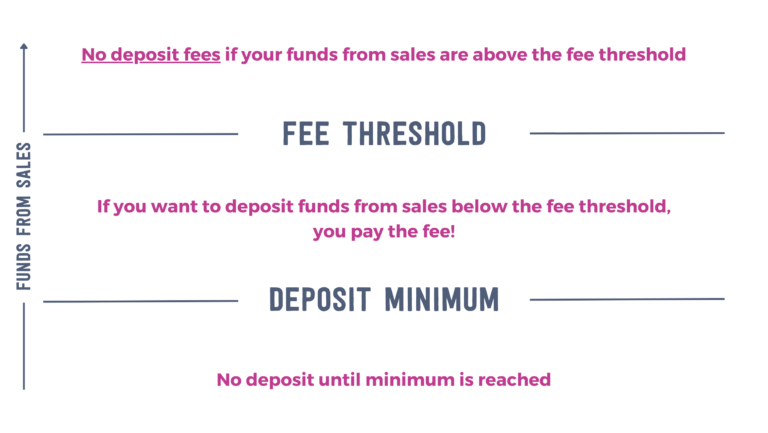
Action step here is checking with the link inside your worksheet if you’re in a country where deposit fees apply, if you are, write how much they are and what the minimum and threshold are under the HOW MUCH column.
Next up, we have…
You also may need to pay a currency conversion fee on your listing. If you list a product in a currency that is different from your bank’s currency, Etsy charges you a 2.5% fee to convert your funds from Etsy Payments to the currency of your bank account.
Next let’s talk about advertising fees.
Advertising fees can come from 2 things:
Let’s start with the first one, offsite ads, which are mandatory for some sellers – but not all.
Offsite ads will advertise your product on websites like Facebook, Instagram, Google, websites, and more.
Etsy’s offsite ads are optional if your Etsy shop has made less than $10,000 USD in the past 365 days, but if you have made over $10,000 then they are required.
For offsite advertising fees you pay a percentage of the sales amount.
If your shop made less than $10,000 USD you will pay a 15% fee on an order (on the total – including shipping and gift wrap) that occurred from someone clicking on your offsite ad.
If your shop made more than $10,000 USD you will pay 12%.
Let’s say you have set up offsite advertising for your lavender candles, and someone Googles “lavender scented candles” and sees your ad pop up.
If they click that ad and purchase a candle, you will have to pay an advertising fee.
Candle $23
Gift wrap $5
Shipping $5
Total $33
Let’s assume your shop earns over $10,000 USD/year. Your offsite advertising fee will be $33 * 12%, or $3.96.
Action step: in your worksheet, write down whether this applies to you or not and what % you will be charged if you need to pay it.
The other kind of advertising fees are for Etsy ads – and this moves us into the fees that are totally and 100% optional for any Etsy seller.
The last fee I want to talk about is the value-added tax, or VAT.
Depending on where you are located, Etsy may be required to collect VAT on your seller fees and pay it to your country’s tax authority.
They may also need to collect VAT on Etsy Payments processing fees, again depending on where you are located.
I have a link on your worksheet to the page that will tell you if Etsy collects VAT for your country and what the rate is.
Even though it isn’t an Etsy fee, it’s something you need to include in your fee calculations.
Etsy advertising fees – unlike offsite ads which become compulsory above $10K – are 100% just if you choose to advertise on Etsy, you don’t have to do it.
Etsy ads are ads that appear on the Etsy site when someone is shopping. So if someone types “lavender candle,” you could pay to have your lavender candle listing show up higher in the results than it would have otherwise.
These ads, called “promoted listings,” use a bidding auction system – the highest bidder for the keyword gets the promoted spot. When you set up your Etsy advertising you will set a daily budget and Etsy will use this information to do your bidding automatically each day.
These ads are just like your Facebook ads or Instagram ads, you pay per click. The amount you pay will depend on how many people click your ads and where your ad appears.
Next let’s talk about other optional fees that you may have to pay depending on what options you choose for your listing.
The first is shipping label fees. Etsy shipping labels are not available in every country and are only offered for certain carriers inside those countries.
If you use one of these carriers, you can choose to print an Etsy shipping label for your package. The fees charged will depend on the weight and dimensions of your package, the origin and destination you are shipping to, as well as any insurance coverage you want to purchase.
Action step: check how much this fee will be in your case with the link in your worksheet.
Another optional fee is the Etsy Pattern Fee.
Pattern is a website builder that allows you to have your own website at your own url but that is still connected to your Etsy seller account.
So for example, if your candle business is called “Candles by Susie,” you can use Pattern to create a website called “candlesbysusie.com,” and have your Etsy listings on this website.
If you choose to have a pattern website, you will be charged $15 USD/month.
Etsy has a partnership with Square that lets sellers sell their products using Square card readers.
If you sync your square reader to your Etsy inventory, you will be charged the transaction and listing fees we have discussed previously
If your inventory is not synced with your square card reader, you will be charged $0.20 per transaction (by Etsy).
Another fee you might encounter is the Etsy seller subscription fee.
Etsy has a subscription service called Etsy Plus that you can enroll in to receive a number of benefits like credits for shop listings and Etsy ads, advanced shop customization, and more.
If you have an Etsy Plus subscription you will be charged a flat $10/month.
Well, congratulations! – you made it through and now you have a good understanding of all of the Etsy fees – cheers to you for sticking with me on this – I know that trying to understand all these different fees can make your brain hurt!
So now let’s put it all together and look at a simple example of what you are going to be paying. I will use an online calculator – there are a ton of them online that you can find if you Google “Etsy fee calculator” – I will use the one from Alura.
Now obviously this is really hard to calculate for an entire shop’s sales because it’s going to depend on so many things. If you sell one product that costs $1,000 the fees will be different than if you had 1000 sales of $1.
So let’s just sum up what the fees that you will definitely pay would be and look at what it could cost you on top of that.
Let’s start off with the candle sale we’ve been using for this article.
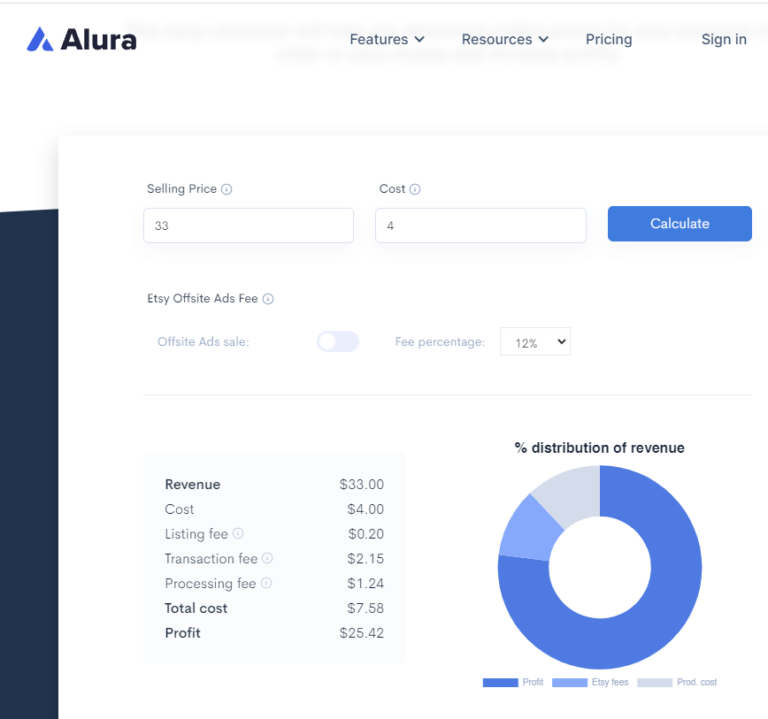

For this sale, your initial sales revenue is $33, and the fee calculator shows that your listing fee will be .20, your transaction fee will be $2.15, and your processing fee will be $1.24.
Now if we use this same example but assume you are using offsite ads (and your shop makes less than $10,000/year), you can toggle the “onsite ads” button on and choose a fee percentage of 15%.
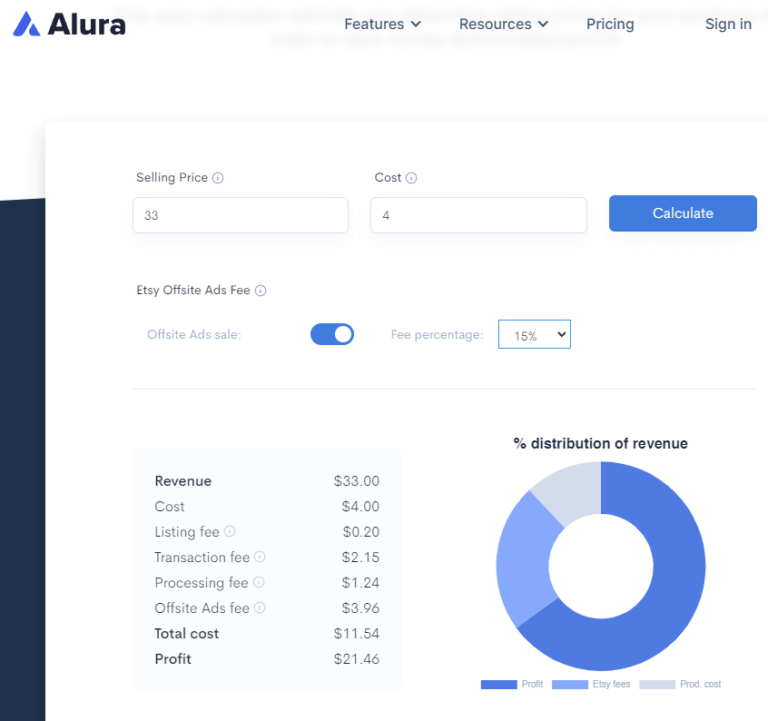

Your fee calculator now shows an offsite ads fee of $3.96 in addition to the fees we listed earlier.
So as you can see, this calculator shows you how much your total fees on Etsy would be and factors in what it costs you to produce this product so that you can see your total profit and profit margin – and that’s how you break down your profit!
This calculator computes your Etsy fees, which is what Etsy charges you, but remember that what you really want to keep an eye on is your total profit and your profit margin, which are going to depend on how much it actually costs you to create this product. This discussion is a whole separate topic, but that’s why you see here that the total profit is much lower than $33 minus $3.58 (here – its’ $21.46), because on top of those fees you pay to Etsy, you have other costs that you have to pay to produce this product (material, labor, etc.)— so it’s very important that you price strategically and with all this in mind so you can make a healthy profit!.
If you haven’t printed out the Etsy Fees Worksheet yet and are ready to calculate your Etsy fees, just click the link and you can get started !
Thanks for reading, and until next time, aurevoir!
you might also like…
related articles

If you want to be found in search results on Etsy, you need to optimize your product listing for SEO. And if you want to
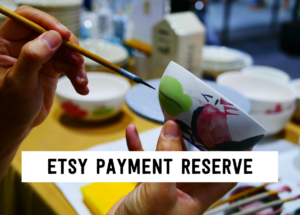
There has been a lot of talk in the Etsy community — and I mean A LOT of talk — about Etsy’s payment account reserve
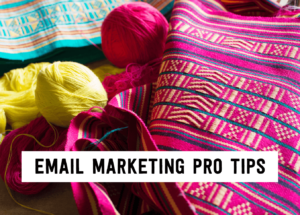
Anyone who knows me knows that I am a HUGE advocate for using email marketing to grow and scale your handmade business. But you may
disclaimer
subscribe to youtube
THE LAUNCHPAD
get in touch
We acknowledge and give thanks to the Budawang and Yuin people, the Traditional Owners of the land we work and live on. We pay our respects to all Aboriginal and Torres Strait Islander Peoples and elders past, present and emerging.
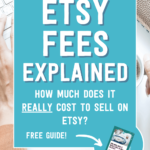
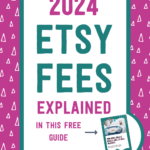

Learn how to grow your business beyond etsy as easily as possible

learn how to grow your online store sales into a consistent and predictable income